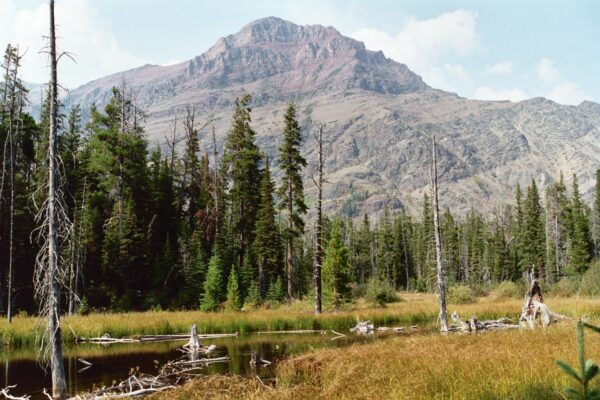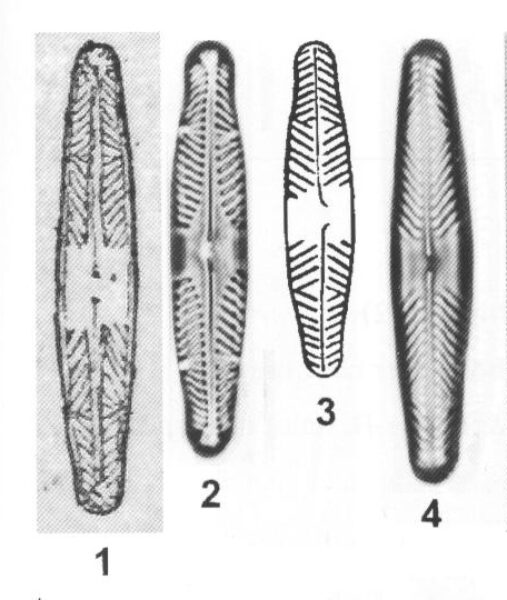Pinnularia divergentissima
-
Category
-
Length Range28-46 µm
-
Width Range5.0-7.0 µm
-
Striae in 10 µm12-14
-
Reported AsPinnularia martinii f. martinii (Krasske 1939)
Pinnularia fottii (Bily and Marvan 1959)
-
ContributorLoren Bahls - Dec 2011
-
ReviewerSarah Spaulding - Mar 2012
Identification
Description
Valves are linear to linear-lanceolate with obtusely rounded, subrostrate apices. The axial area is narrow and linear. The central area is a broad fascia reaching the valve margins. Raphe branches are filiform and straight. Proximal raphe ends are small, deflected to one side, and close to one another. Terminal raphe fissures are hooked. Striae are extremely radiate near the valve center and become extremely convergent about half way to the apices. The change in striae direction is sudden, forming an acute angle between the two striae groups where they meet.
Autecology
Pinnularia divergentissima has been recorded from 12 creeks, ponds, and small lakes in the Northwest United States. In these waters mean pH is 7.4, mean specific conductance is 41 μS/cm, and common diatom associates are Neidium bisulcatum, Cymbopleura subrostrata, Denticula valida, Caloneis leptosoma, and Eunotia praerupta. Elsewhere in the U. S., this species has been reported from Ohio and Wyoming (Patrick and Reimer 1966) and from low-alkalinity lakes in New York (Camburn and Charles 2000). Patrick and Reimer (1966) report that it prefers cold water and is often found in mountainous country. Krammer (2000) reports this species as cosmopolitan in northern alpine zones, particularly on mosses in forests, in meadows, or in waters with low electrolyte content.
-
Size Range, µm3
-
Motility
-
Attachment
-
Habitat
-
Colony
-
Occurrence
-
BCG
-
Waterbody
-
Distribution
- Learn more about this
Citations & Links
Citations
Links
-
Index Nominum Algarum
-
North American Diatom Ecological DatabaseNADED ID: 52027
Cite This Page
Bahls, L. (2011). Pinnularia divergentissima. In Diatoms of North America. Retrieved July 26, 2024, from https://diatoms.org/species/pinnularia_divergentissima
Responses
The 15 response plots show an environmental variable (x axis) against the relative abundance (y axis) of Pinnularia divergentissima from all the stream reaches where it was present. Note that the relative abundance scale is the same on each plot. Explanation of each environmental variable and units are as follows:
ELEVATION = stream reach elevation (meters)
STRAHLER = distribution plot of the Strahler Stream Order
SLOPE = stream reach gradient (degrees)
W1_HALL = an index that is a measure of streamside (riparian) human activity that ranges from 0 - 10, with a value of 0 indicating of minimal disturbance to a value of 10 indicating severe disturbance.
PHSTVL = pH measured in a sealed syringe sample (pH units)
log_COND = log concentration of specific conductivity (µS/cm)
log_PTL = log concentration of total phosphorus (µg/L)
log_NO3 = log concentration of nitrate (µeq/L)
log_DOC = log concentration of dissolved organic carbon (mg/L)
log_SIO2 = log concentration of silicon (mg/L)
log_NA = log concentration of sodium (µeq/L)
log_HCO3 = log concentration of the bicarbonate ion (µeq/L)
EMBED = percent of the stream substrate that is embedded by sand and fine sediment
log_TURBIDITY = log of turbidity, a measure of cloudiness of water, in nephelometric turbidity units (NTU).
DISTOT = an index of total human disturbance in the watershed that ranges from 1 - 100, with a value of 0 indicating of minimal disturbance to a value of 100 indicating severe disturbance.

Pinnularia divergentissima
- Striae with abrupt transition
- Valves linear to linear-lanceolate
- Apices subrostrate and obtusely rounded
- Raphe straight
- Proximal raphe ends closely spaced
Valves are striking in appearance because of the abrupt transition from extremely radiate to extremely convergent striae. Valves are linear to linear-lanceolate with subrostrate and obtusely-rounded apices. Raphe branches are filiform and the proximal raphe ends are small and close to one another.
 Diatoms of North America
Diatoms of North America






